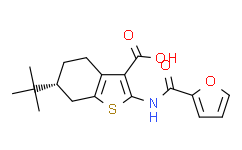| Cas No.: | 407587-33-1 |
| Chemical Name: | CaCCinh-A01 |
| Synonyms: | CaCCinh-A01;6-t-butyl-2-(furan-2-carboxamido)-4,5,6,7-tetrahydrobenzo[b]thiophene-3-carboxylic acid;6-(1,1-Dimethylethyl)-2-[(2-furanylcarbonyl)amino]-4,5,6,7-tetrahydro-benzo[b]thiophene-3-carboxylic acid |
| SMILES: | O=C(C1=C(NC(C2=CC=CO2)=O)SC3=C1CCC(C(C)(C)C)C3)O |
| Formula: | C18H21NO4S |
| M.Wt: | 347.428643941879 |
| Purity: | >98% |
| Sotrage: | 2 years -20°C Powder, 2 weeks 4°C in DMSO, 6 months -80°C in DMSO |
| Description: | CaCCinh-A01 is an inhibitor of both TMEM16A and calcium-activated chloride channel (CaCC) with IC50s of 2.1 and 10 μM, respectively. |
| Target: | IC50: 2.1 μM (TMEM16A)[1], 10 μM (CaCC)[2] |
| In Vitro: | 30 μM CaCCinh-A01 and 100 μM tannic acid strongly inhibit CaCC current following ATP stimulation[1]. Calcium-dependent chloride current is reduced by 38±14, 66±10, and 91±1% by 0.1, 1, and 10 μM CaCCinh-A01, respectively. ATP-induced short-circuit currents are reduced by 38±7 and 78±3% at 10 and 30 μM CaCCinh-A01, respectively[2]. |
| Cell Assay: | Each well of a 96-well plate is washed three times with PBS (200 μL/wash), leaving 50 μL of PBS. Test compounds (including CaCCinh-A01) (0.5 μL) are added to each well at 25 μM final concentration. After 10 min, 96-well plates are transferred to a plate reader for fluorescence assay. Each well is assayed individually for TMEM16A-mediated I- influx by recording fluorescence continuously (400 ms/point) for 2 s (base line), then 50 μL of a 140 mM I- solution containing 200 μM ATP is added. The initial rate of I- influx is computed from fluorescence data by nonlinear regression[1]. |
| References: | [1]. TMEM16A inhibitors reveal TMEM16A as a minor component of calcium-activated chloridechannel conductance in airway and intestinal epithelial cells. J Biol Chem. 2011 Jan 21;286(3):2365-74. [2]. De La Fuente R, et al. Small-molecule screen identifies inhibitors of a human intestinal calcium-activated chloridechannel. Mol Pharmacol. 2008 Mar;73(3):758-68. |

 To enhance service speed and avoid tariff delays, we've opened a US warehouse. All US orders ship directly from our US facility.
To enhance service speed and avoid tariff delays, we've opened a US warehouse. All US orders ship directly from our US facility.




















